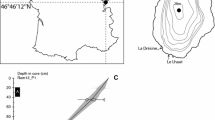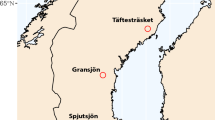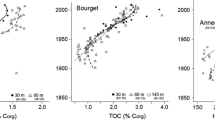Abstract
Freshwater lakes are important sources of methane (CH4) emissions, by organic matter degradation under anaerobic conditions (methanogenesis). Previous studies suggest that lakes contribute up to 16 % of natural emissions. About 60 % of the CH4 produced is used as an energy source by methane-oxidizing bacteria (MOB—methanotrophs), which could support higher trophic levels, especially Chironomidae (Diptera). Because biogenic methane has a very low stable carbon isotope value, evidence of methane-derived organic-matter assimilation can be tracked by stable carbon isotope analysis in consumers such as chironomids. In some cases, however, chironomid δ13C values are not low enough to unambiguously demonstrate methanotroph assimilation and an alternative line of evidence is required. Analysis of ancient DNA (aDNA) from the methanotroph community preserved in lake sediment provides reliable information about past methane oxidation in freshwater lakes. A combination of these two approaches was used to study a sediment core from the deepest zone of Lake Narlay (Jura, France), which covers the last 1,500 years of sediment accumulation. Results show a significant change ca. AD 1600, with an increase in the proportion of MOB in the total bacteria community, and a decrease in chironomid head-capsule δ13C. These trends suggest assimilation of MOB by chironomid larvae, and account for up to 36 % of the chironomid biomass. The data also provide information about the feeding behavior of chironomids, with evidence for preferential assimilation of methanotroph type I and the NC10 phylum. The combination of aDNA analysis and carbon stable isotopes strengthens the reliability of inferences about carbon sources incorporated into chironomid biomass.





Similar content being viewed by others
References
Appleby PG, Richardson N, Nolan PJ (1991) 241Am dating of lake sediments. Hydrobiologia 214:35–42
Armitage PD, Cranston PS, Pinder LCV (1995) The Chironomidae. The biology and ecology of non-biting midges. Chapman & Hall, London
Bastviken D, Cole J, Pace M, Tranvik L (2004) Methane emissions from lakes: dependence of lake characteristics, two regional assessments, and a global estimate. Glob Biogeochem Cycle 18:GB4009
Bennett KD (1996) Determination of the number of zones in a biostratigraphical sequence. New Phytol 132:155–170
Berg HB (1995) Larval food and feeding behavior. In: Armitage PD, Cranston PS, Pinder LCV (eds) The Chironomidae: biology and ecology of non-biting midges. Chapman & Hall, London, pp 136–168
Blaauw M (2010) Methods and code for “classical” age-modelling of radiocarbon sequences. Quat Geochronol 5:512–518
Borrel G, Jézéquel D, Biderre-Petit C, Morel-Desrosiers N, Morel JP, Peyret P, Fonty G, Lehours AC (2011) Production and consumption of methane in freshwater lake ecosystems. Res Microbiol 162:832–847
Borrel G, Lehours AC, Crouzet O, Jézéquel D, Rockne K, Kulczak A, Duffaud E, Joblin K, Fonty G (2012) Stratification of Archaea in the deep sediments of a freshwater meromictic lake: vertical shift from methanogenic to uncultured Archaeal lineages. PLoS ONE 7:e43346
Brooks SJ, Langdon PG, Heiri O (2007) The identification and use of Palaearctic Chironomidae larvae in palaeoecology. QRA Technical Guide No. 10 Quaternary Research Association, London, p 276
Bunn SE, Boon PI (1993) What sources of organic carbon drive food webs in billabongs? A study based on stable isotope analysis. Oecologia 96:85–94
Chen Y, Dumont MG, Cébron A, Murrell JC (2007) Identification of active methanotrophs in a landfill cover soil through detection of expression of 16S rRNA and functional genes. Environ Microbiol 9:2855–2869
Coolen MJL, Hopmans EC, Rijpstra WIC, Muyzer G, Schouten S, Volkman JK, Sinninghe Dmasté JS (2004) Evolution of the methane cycle in Ace Lake (Antarctica) during the Holocene: response of methanogens and methanotrophs to environmental change. Org Geochem 35:1151–1167
Coolen MJ, Muyzer G, Schouten S, Volkman JK, Sinninghe Damsté JS (2006) Sulfur and methane cycling during the Holocene in Ace Lake (Antarctica) revealed by lipid and DNA stratigraphy. Past and Present Water Column Anoxia. Springer, Berlin, pp 41–65
Deines P, Bodelier PLE, Eller G (2007) Methane-derived carbon flows through methane-oxidizing bacteria to higher trophic levels in aquatic systems. Environ Microbiol 9:1126–1134
Deines P, Wooller MJ, Grey J (2009) Unravelling complexities in benthic food webs using a dual stable isotope (hydrogen and carbon) approach. Freshw Biol 54:2243–2251
Doi H, Kikuchi E, Takagi S, Shikano S (2006) Selective assimilation by deposit feeders: experimental evidence using stable isotope ratios. Basic Appl Ecol 7:159–166
Eller G, Deines P, Grey J, Richnow HH, Krüger M (2005) Methane cycling in lake sediments and its influence on chironomid larval δ13C. FEMS Microb Ecol 54:339–350
Ettwig KF, van Alen T, van de Pas-Schoonen KT, Jetten MSM, Strous M (2009) Enrichment and molecular detection of denitrifying methanotrophic bacteria of the NC10 phylum. Appl Environ Microb 75:3656–3662
Fernandes M, Krull E (2008) How does acid treatment to remove carbonates affect the isotopic and elemental composition of soils and sediments? Environ Chem 5:33–39
Frossard V, Belle S, Verneaux V, Magny M (2013a) A study of the δ13C offset between chironomid larvae and their exuvial head capsules: implications for palaeoecology. J Paleolimnol 50:379–386
Frossard V, Verneaux V, Millet L, Jenny JP, Arnaud F, Magny M, Perga ME (2013b) Reconstructing long-term changes (150 years) in the carbon cycle of a clear-water lake based on the stable carbon isotope composition (δ13C) of chironomid and cladoceran subfossil remains. Freshw Biol 59:789–802
Giraudoux P (2012) pgirmess: data analysis in ecology. R package version 1.5.6. http://CRAN.R-project.org/package=pgirmess
Goedkoop W, Akerblom N, Demandt MH (2006) Trophic fractionation of carbon and nitrogen stable isotopes in Chironomus riparius reared on food of aquatic and terrestrial origin. Freshw Biol 51:878–886
Grey J, Deines P (2005) Differential assimilation of methanotrophic and chemoautotrophic bacteria by lake chironomid larvae. Aquat Microb Ecol 40:61–66
Grey J, Jones RI (1999) Carbon stable isotopes reveal complex trophic interactions in lake plankton. Rapid Commun Mass Spectrom 13:1311–1314
Grey J, Kelly A, Jones RI (2004) High intraspecific variability in carbon and nitrogen stable isotope ratios of lake chironomid larvae. Limnol Oceano 49:239–244
Hanson RS, Hanson TE (1996) Methanotrophic bacteria. Microbiol Rev 60:439–471
Harris D, Horwath WR, van Kessel C (2001) Acid fumigation of soils to remove carbonates prior to total organic carbon or carbon-13 isotopic analysis. Soil Sci Soc Am J 65:1853–1856
He R, Wooller MJ, Pohlman JW, Quensen J, Tiedje JM, Leigh MB (2012) Diversity of active aerobic methanotrophs along depth profiles of arctic and subarctic lake water column and sediments. ISME J 6:1937–1948
Jones RI, Grey J (2011) Biogenic methane in freshwater food webs. Freshw Biol 56:213–229
Jones RI, Grey J, Sleep D, Quarmby C (1998) An assessment, using stable isotopes, of the importance of allochthonous organic carbon sources to the pelagic food web in Loch Ness. Proc R Soc B-Biol Sci 265:105–110
Jones RI, Carter CE, Kelly A, Ward S, Kelly DJ, Grey J (2008) Widespread contribution of methane-cycle bacteria to the diets of lake profundal chironomid larvae. Ecology 89:857–864
Juggins S (2012) rioja: analysis of quaternary science data, R package version 0.7-3. http://cran.r-project.org/package=rioja
Kajan R, Frenzel P (1999) The effect of chironomid larvae on production, oxidation and fluxes of methane in a flooded rice soil. FEMS Microbiol Ecol 28:121–129
Kelly A, Jones RI, Grey J (2004) Stable isotope analysis provides fresh insights into dietary separation between Chironomus anthracinus and C. plumosus. J N Am Benthol Soc 23:287–296
Killick R, Eckley IA (2012) Changepoint: an R package for changepoint analysis. R package version 0.8. http://CRAN.R-project.org/package=changepoint
Kiyashko SI, Imbs AB, Narita T, Svetashev VI, Wada E (2004) Fatty acid composition of aquatic insect larvae Stictochironomus pictulus (Diptera: Chironomidae): evidence of feeding upon methanotrophic bacteria. Comp Biochem Phys B 139:705–711
Kojima H, Tsutsumi M, Ishikawa K, Iwata T, Mußmann M, Fukui M (2012) Distribution of putative denitrifying methane oxidizing bacteria in sediment of a freshwater lake, Lake Biwa. Syst Appl Microbiol 35:233–238
Komada T, Anderson MR, Dorfmeier CL (2008) Carbonate removal from coastal sediments for the determination of organic carbon and its isotopic signatures, δ13C and δ14C: comparison of fumigation and direct acidification by hydrochloric acid. Limnol Oceanogr Methods 6:254–262
Krishnaswamy S, Lal D, Martin JM, Meybeck M (1971) Geochronology of lake sediments. Earth Planet Sci Lett 11:407–414
Lan DJ (1991) 16S/23S rRNA sequencing. In: Stackebrandt E, Goodfellow M (eds) Nucleic acid techniques in bacterial systematics. Wiley, Chichester, pp 115–175
Liikanen A, Martikainen PJ (2003) Effect of ammonium and oxygen on methane and nitrous oxide fluxes across sediment–water interface in a eutrophic lake. Chemosphere 52:1287–1293
Livak KJ, Schmittgen TD (2001) Analysis of relative gene expression data using real-time quantitative PCR and the 2−ΔΔCT Method. Method 25:402–408
McCallister SL, del Giorgio PA (2008) Direct measurement of the δ13C signature of carbon respired by bacteria in lakes: linkages to potential carbon sources, ecosystem baseline metabolism, and CO2 fluxes. Limnol Oceanogr 53:1204–1216
Muyzer G, de Waal EC, Uitterlinden AG (1993) Profiling of complex microbial populations by denaturing gradient gel electrophoresis analysis of polymerase chain reaction-amplified genes coding for 16S rRNA. Appl Environ Microbiol 59:695–700
Oksanen J, Blanchet G, Kindt R, Legendre P, O’Hara R, Simpson G, Solymos P, Stevens H, Wagner H (2012) Vegan: community ecology package. R package version 1.17-11. http://CRAN.R-project.org/package=vegan
Perga ME, Desmet M, Enters D, Reyss JL (2010) A century of bottom-up- and top-down-driven changes on a lake planktonic food web: a paleoecological and paleoisotopic study of Lake Annecy, France. Limnol Oceanogr 55:803–816
Phillips DL, Gregg JW (2001) Uncertainty in source partitioning using stable isotopes. Oecologia 127:171–179
Ramnarine R, Voroney RP, Wagner-Riddle C, Dunfield KE (2011) Carbonate removal by acid fumigation for measuring the δ13C of soil organic carbon. Can J Soil Sci 91:247–250
R Core Team (2012) R: a language and environment for statistical computing. R Foundation for Statistical Computing, Vienna, Austria. ISBN 3-900051-07-0. http://www.R-project.org
Rau G (1978) Carbon-13 depletion in a subalpine lake: carbon flow implications. Science 201:901–902
Reyss JL, Schmidt S, Legeleux F, Bonté P (1995) Large, low background well-type detectors for measurements of environmental radioactivity. Nucl Instrum Methods Phys Res, Sect A 357:391–397
Robbins JA, Edgington DN (1975) Determination of recent sedimentation rates in Lake Michigan using 210Pb and 137Cs. Geochim Cosmochim Acta 39:285–304
Sanseverino AM, Bastviken D, Sundh I, Pickova J, Enrich-Prast A (2012) Methane carbon supports aquatic food webs to the fish level. PLoS ONE 7:e42723
Schubert CJ, Vazquez F, Lösekann-Behrens T, Knittel K, Tonolla M, Boetius A (2011) Evidence for anaerobic oxidation of methane in sediments of a freshwater system (Lago di Cadagno). FEMS Microbiol Ecol 76:26–38
Solomon CT, Carpenter SR, Cole JJ, Pace ML (2008) Support of benthic invertebrates by detrital resources and current autochthonous primary production: results from a whole-lake 13C addition. Freshw Biol 53:42–54
Summons RE, Jahnke LL, Roksandic Z (1994) Carbon isotopic fractionation in lipids from methanotrophic bacteria: relevance for interpretation of the geochemical record of biomarkers. Geochim Cosmochim Acta 58:2853–2863
Templeton AS, Chu KH, Alvarez-Cohen L, Conrad ME (2006) Variable carbon isotope fractionation expressed by aerobic CH4-oxidizing bacteria. Geochim Cosmochim Acta 70:1739–1752
Thauer RK, Shima S (2006) Biogeochemistry: methane and microbes. Nature 440:878–879
Thauer RK, Kaster A-K, Seedorf H, Buckel W, Hedderich R (2008) Methanogenic archaea: ecologically relevant differences in energy conservation. Nat Rev Microbiol 6:579–591
Van Hardenbroek M, Heiri O, Grey J, Bodelier PLE, Verbruggen F, Lotter AF (2010) Fossil chironomid δ13C as a proxy for past methanogenic contribution to benthic food webs in lakes? J Paleolimnol 43:235–245
Van Hardenbroek M, Heiri O, Parmentier FJW, Bastviken D, Ilyashuk B, Wiklund J, Hall R, Lotter A (2013) Evidence for past variations in methane availability in a Siberian thermokarst lake based on δ13C of chitinous invertebrate remains. Quat Sci Rev 66:74–84
Vuorio K, Meili M, Sarvala J (2006) Taxon-specific variation in the stable isotopic signatures (δ13C and δ15N) of lake phytoplankton. Freshw Biol 51:807–822
Wagner A, Volkmann S, Dettinger-Klemm PMA (2012) Benthic–pelagic coupling in lake ecosystems: the key role of chironomid pupae as prey of pelagic fish. Ecosphere 3:art14
Wang B, Lui CQ, Peng X, Wang F (2013) Mechanisms controlling the carbon stable isotope composition of phytoplankton in karst reservoirs. J Limnol 72:127–139
Whiticar MJ (1999) Carbon and hydrogen isotope systematics of bacterial formation and oxidation of methane. Chem Geol 161:291–314
Winfrey MR, Zeikus JG (1979) Microbial methanogenesis and acetate metabolism in a meromictic lake. Appl Environ Microbiol 37:213–221
Wooller MJ, Pohlman JW, Gaglioti BV, Langton P, Jones M, Walter Anhony KT, Becker KW, Hinrichs KU, Elvert M (2012) Reconstruction of past methane availability in an Arctic Alaska wetland indicates climate influenced methane release during the past ~12,000 years. J Paleolimnol 48:27–42
Yasuno N, Shikano S, Muraoka A, Shimada T, Ito T, Kikushi E (2011) Seasonal increase of methane in sediment decreases δ13C of larval chironomids in a eutrophic shallow lake. Limnology 13:107–116
Acknowledgments
Financial support for this study was provided by the Conseil Regional de Franche-Comté. We thank Christian Hossann and Claude Bréchet (INRA Nancy, Champenoux) for assistance with stable isotope analysis. The authors gratefully acknowledge James Dat for improvement of the English text. We also thank Steve Brooks and the two anonymous reviewers for their constructive comments.
Author information
Authors and Affiliations
Corresponding author
Rights and permissions
About this article
Cite this article
Belle, S., Parent, C., Frossard, V. et al. Temporal changes in the contribution of methane-oxidizing bacteria to the biomass of chironomid larvae determined using stable carbon isotopes and ancient DNA. J Paleolimnol 52, 215–228 (2014). https://doi.org/10.1007/s10933-014-9789-z
Received:
Accepted:
Published:
Issue Date:
DOI: https://doi.org/10.1007/s10933-014-9789-z




